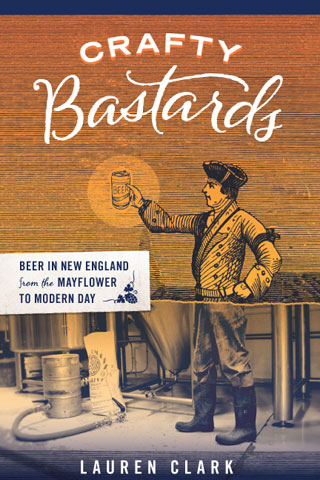December 22nd, 2007
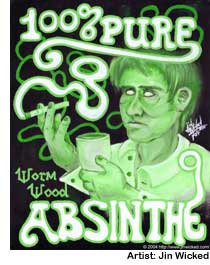 Unless you haven’t picked up a newspaper recently, you know that absinthe — the strong, licoricey liqueur with the naughty reputation — is once again legal in the U.S. after a long ban beginning in 1912.
Unless you haven’t picked up a newspaper recently, you know that absinthe — the strong, licoricey liqueur with the naughty reputation — is once again legal in the U.S. after a long ban beginning in 1912.
All the articles I’ve read about the spirit and its newly legit status seemingly rummaged through the same musty steamer trunk full of anecdotes and phrases associated with the Green Fairy: the supposed hallucinogenic, madness-inducing effects; the Belle Epoque and its absinthe-drinking artists, particularly the troubled ear slicer Van Gogh; the Swiss man who sparked the ban of absinthe in Europe by murdering his family while drunk on absinthe in 1905; the word “louche,” which originally referred to the cloudiness that forms in the beverage during the ritual of dripping ice water slowly into the glass. All of the articles quote the chemist and absinthe historian Ted Breaux, who consulted on the creation of Lucid, the first absinthe on the American market. And they all employ that nonchalant tone newspapers use when reporting the latest craze over something controversial.
The story behind absinthe is indeed interesting, but, honestly, I felt like I’ve read the same article about seven times. Until I saw the one that Salon published this week: “Everything you know about absinthe is wrong.”
“Let’s clear up a few misconceptions,” says the writer, Sarah Hepola. “Absinthe does not make you hallucinate. It is not wildly addictive. It will not cause you to lop off your ear, unless (possibly, on the off-chance) you are a deeply disturbed painter racked by poverty, heartbreak and mental illness. Rather, absinthe is a good drink.” Strip away all the “lore and illegality,” she argues, and what you actually have is a damn fine, complex beverage that deserves a place in the world of legal spirits.
But the lore and the lingering whiff of illegality are, of course, precisely why people are lining up at bars to order absinthe and take part in its peculiar serving rituals, with their slotted spoons, sugar cubes and fancy ice water fountains. And they’re why the new absinthes on the market cost $60-$75 per bottle. Sure, distilling a good quality absinthe takes knowledge and skill. But that’s true of a lot of herb-based spirits — green Chartreuse comes to mind. Its strength is similar to that of absinthe, it has been rumored to have mind-altering properties, and its complex recipe requires the distiller to be meticulous. But at around $35-$40 per bottle, it seems a relative bargain.
Jared Gurfein, president of Viridian Spirits, which produces Lucid, says in the Salon article, “We’ve sold thousands more cases than expected. There is a huge interest in absinthe. Unbelievable.”
Cashing in on hype over a product, whether that product is good or bad, is nothing new. But I would say to today’s absinthe drinker: if you don’t realize that hype is what you’re paying good money for, you must be hallucinating.
Posted in Absinthe, Booze in the news, Liqueur | 5 Comments »
July 27th, 2007

Wow. As we say in New England, that was wicked awesome. The last time I was in New Orleans, I was a dumb college kid hanging out on Bourbon St. drinking Hurricanes with the rest of the tourists. Fast-forward many years to Tales of the Cocktail 2007, where I attended seminars on vermouth and pimento dram and drank Pimm’s Cups at the honorable Napoleon House. The older, wiser me had a much better time.
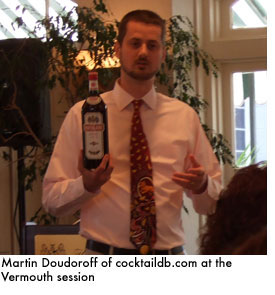 If drinking cocktails for breakfast, lunch and dinner, then going out at night for more cocktails, is your idea of heaven, this is the event — and the town — for you. At a 10 a.m. session on applejack, we were served a Golden Dawn, a Jack Rose and a Wicked Kiss (a Widow’s Kiss with the addition of rye whiskey). Haigh (Vintage Spirits and Forgotten Cocktails), Gary Regan (The Joy of Mixology, Regan’s Orange Bitters), and Chad Solomon and Christy Pope (Cuff & Buttons) presided over the seminar with an unofficial fifth panelist: Lisa Laird of the Laird family. Yes, that Laird family, the ones who have produced Laird’s Applejack since the 1700s and who had George Washington over for dinner before the Battle of Monmouth. The cocktails were made with bonded Applejack, which is distilled with 100-percent apples (no grain neutral spirits) and aged for four years — and which, as far as I know, cannot be had in the Boston area. Too bad.
If drinking cocktails for breakfast, lunch and dinner, then going out at night for more cocktails, is your idea of heaven, this is the event — and the town — for you. At a 10 a.m. session on applejack, we were served a Golden Dawn, a Jack Rose and a Wicked Kiss (a Widow’s Kiss with the addition of rye whiskey). Haigh (Vintage Spirits and Forgotten Cocktails), Gary Regan (The Joy of Mixology, Regan’s Orange Bitters), and Chad Solomon and Christy Pope (Cuff & Buttons) presided over the seminar with an unofficial fifth panelist: Lisa Laird of the Laird family. Yes, that Laird family, the ones who have produced Laird’s Applejack since the 1700s and who had George Washington over for dinner before the Battle of Monmouth. The cocktails were made with bonded Applejack, which is distilled with 100-percent apples (no grain neutral spirits) and aged for four years — and which, as far as I know, cannot be had in the Boston area. Too bad.
At Prohibition’s Shadow, which featured Haigh, David Wondrich, Robert Hess (drinkboy.com) and John Hall (distiller of Forty Creek Canadian whiskey), we sipped samples of Forty Creek, a blend of rye, corn and barley whiskies, all distilled separately then blended. That stuff was righteously smooth and had flavors of an old ale, like Thomas Hardy’s. Why Canadian whiskey? Well, where do you think speakeasies got their whiskey during Prohibition? The session itself turned into a bit of a speakeasy when John Myers, bartender, cocktail historian and author of the Thirstin’ Howl, suddenly pulled a bottle of Fernet out of his bag and began dispensing shots. Perfectly appropriate at this sort of convention.
Cocktails and the Blogosphere, another 10 a.m. session (oh, my head!) involved Fancy Free and Police Gazette cocktails by way of illustrating how obscure drinks get re-discovered and popularized through blogs. Full of whiskey and bitters, these are two libations that’ll set the vintage-cocktail enthusiast’s heart aflutter. Paul Clark (Cocktail Chronicles), Chuck Taggart (Gumbo Pages), Darcy O’Neil (The Art of Drink) and Rick Stutz (Kaiser Penguin) presided. The session’s money quote (by Paul, I think): “At the 10th anniversary of Tales of the Cocktail, we’ll be talking about the recently launched 100,000th drink blog.”
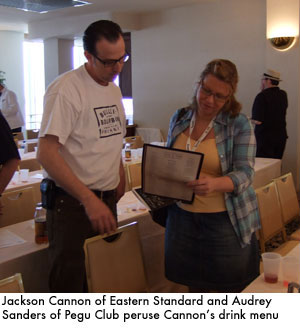
The money quote from the session simply titled Vermouth (with Haigh and Martin Doudoroff, the geniuses behind cocktaildb.com) came from Haigh just as we started: “It’s 11:30 in the morning, and you guys are at a session on vermouth? Get a life!” We sipped a Marconi Wireless (speaking of bloggers rediscovering old drinks) and a Rose and learned that it’s really hard to get information from vermouth producers (Martini & Rossi, Noilly Prat, etc.) on the spices they use to turn red or white wine into a classic cocktail ingredient. One of the panelists did manage to get hold of some info, and she recited a list of ingredients used in M&R and NP, but I was way beyond note taking at that point.
The Lost Ingredients session was a trip. I had never even heard of pimento dram or Batavia arrack, much less tasted them, before that day. The session was basically a live interpretation of “Gone but Not Forgotten,” the article Clarke wrote for the current issue of Imbibe. I urge any cocktail enthusiast to pick up that issue, because Clarke’s article includes info (and some recipes) on some of the amazing, re-emerging spirits we sampled at Lost Ingredients, including: pimento dram, a rum-based, allspice-flavored liqueur rarely found outside Jamaica — we sampled Taggart’s homemade version; Batavia arrack, a sugar cane- and fermented rice-based spirit produced in Java (formerly the Dutch colony of Batavia) and the basis of Swedish punsch; and falernum, a low-alcohol syrup flavored with limes, ginger, almonds and clove and a key ingredient in many tiki drinks. Read more about the Lost Ingredients session here.
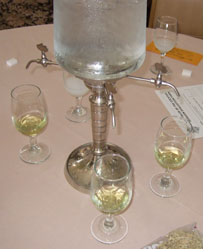 Finally, Sunday brunch: absinthe with a little sugar. I walked into that session a little late, and when I entered the room … wow, the licorice perfume enveloped me, a sensory experience I’ll never forget. Chemist and absinthe expert Ted Breaux gave a comprehensive presentation about absinthe history, myth and legal status, which is apparently still kind of fuzzy in the U.S. He devised the recipe for the new, legal-in-the-U.S. absinthe Lucid, which contains wormwood but only a barely measurable amount of wormwood’s active and feared ingredient, thujone. Anyhoo… somehow we were drinking real Swiss and French absinthe (the latter produced from a recipe of Breaux’s) in the traditional way, by very slowly letting ice water drip into the glass until the liquid became cloudy. This stuff was strong — over 130 proof! I don’t think absinthe should be banned, but I’m not sure if I recommend it as the first meal of the day.
Finally, Sunday brunch: absinthe with a little sugar. I walked into that session a little late, and when I entered the room … wow, the licorice perfume enveloped me, a sensory experience I’ll never forget. Chemist and absinthe expert Ted Breaux gave a comprehensive presentation about absinthe history, myth and legal status, which is apparently still kind of fuzzy in the U.S. He devised the recipe for the new, legal-in-the-U.S. absinthe Lucid, which contains wormwood but only a barely measurable amount of wormwood’s active and feared ingredient, thujone. Anyhoo… somehow we were drinking real Swiss and French absinthe (the latter produced from a recipe of Breaux’s) in the traditional way, by very slowly letting ice water drip into the glass until the liquid became cloudy. This stuff was strong — over 130 proof! I don’t think absinthe should be banned, but I’m not sure if I recommend it as the first meal of the day.
In my next post, I’ll provide some snapshots of what happened outside of the Tales of the Cocktail sessions.
Posted in Absinthe, Applejack, Cocktails, Events, New Orleans, Vermouth, Whiskey | 6 Comments »
March 27th, 2007
 If you’re curious about absinthe, aka the “green fairy,” check out the Virtual Absinthe Museum. You could lose an afternoon there as easily as if you were actually drinking the stuff.
If you’re curious about absinthe, aka the “green fairy,” check out the Virtual Absinthe Museum. You could lose an afternoon there as easily as if you were actually drinking the stuff.
“It’s the fruit of many years’ research and is the largest and most authoritative site on the internet devoted to the history and lore of absinthe,” says David Nathan-Maister, who publishes the site and runs Oxygénée Ltd., a U.K.-based business devoted to all things absinthe, including both new and vintage bottles of the storied herbal spirit. The company takes its name from a poster advertising Cusenier’s Absinthe Oxygénée, “one of the greatest brands of the era” — the “era” being the time before absinthe was banned in 1915. The ban (which has been lifted in Europe but not the U.S.) and lots of other fun facts are covered in the site’s Absinthe FAQ. And you can buy nice, Art Nouveau posters there, too.
Posted in Absinthe, Books & resources, Liqueur | 3 Comments »
 Unless you haven’t picked up a newspaper recently, you know that absinthe — the strong, licoricey liqueur with the naughty reputation — is once again legal in the U.S. after a long ban beginning in 1912.
Unless you haven’t picked up a newspaper recently, you know that absinthe — the strong, licoricey liqueur with the naughty reputation — is once again legal in the U.S. after a long ban beginning in 1912.
 If drinking cocktails for breakfast, lunch and dinner, then going out at night for more cocktails, is your idea of heaven, this is the event — and the town — for you. At a 10 a.m. session on applejack, we were served a
If drinking cocktails for breakfast, lunch and dinner, then going out at night for more cocktails, is your idea of heaven, this is the event — and the town — for you. At a 10 a.m. session on applejack, we were served a 
 Finally, Sunday brunch: absinthe with a little sugar. I walked into that session a little late, and when I entered the room … wow, the licorice perfume enveloped me, a sensory experience I’ll never forget. Chemist and absinthe expert Ted Breaux gave a comprehensive presentation about absinthe history, myth and legal status, which is apparently still kind of fuzzy in the U.S. He devised the recipe for the new, legal-in-the-U.S. absinthe Lucid, which contains wormwood but only a barely measurable amount of wormwood’s active and feared ingredient, thujone. Anyhoo… somehow we were drinking real Swiss and French absinthe (the latter produced from a recipe of Breaux’s) in the traditional way, by very slowly letting ice water drip into the glass until the liquid became cloudy. This stuff was strong — over 130 proof! I don’t think absinthe should be banned, but I’m not sure if I recommend it as the first meal of the day.
Finally, Sunday brunch: absinthe with a little sugar. I walked into that session a little late, and when I entered the room … wow, the licorice perfume enveloped me, a sensory experience I’ll never forget. Chemist and absinthe expert Ted Breaux gave a comprehensive presentation about absinthe history, myth and legal status, which is apparently still kind of fuzzy in the U.S. He devised the recipe for the new, legal-in-the-U.S. absinthe Lucid, which contains wormwood but only a barely measurable amount of wormwood’s active and feared ingredient, thujone. Anyhoo… somehow we were drinking real Swiss and French absinthe (the latter produced from a recipe of Breaux’s) in the traditional way, by very slowly letting ice water drip into the glass until the liquid became cloudy. This stuff was strong — over 130 proof! I don’t think absinthe should be banned, but I’m not sure if I recommend it as the first meal of the day. If you’re curious about absinthe, aka the “green fairy,” check out the
If you’re curious about absinthe, aka the “green fairy,” check out the 